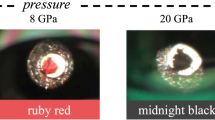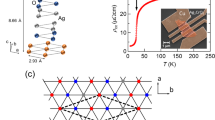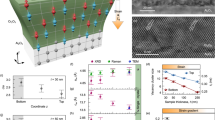Abstract
Several materials have been identified over the past few years as promising candidates for the development of new generations of magnetoresistive devices. These range from artificially engineered magnetic multilayers1 and granular alloys2,3, in which the magnetic-field response of interfacial spins modulates electron transport to give rise to ‘giant’ magnetoresistance4, to the manganite perovskites5,6,7, in which metal–insulator transitions driven by a magnetic field give rise to a ‘colossal’ magnetoresistive response (albeit at very high fields). Here we describe a hitherto unexplored class of magnetoresistive compounds, the silver chalcogenides. At high temperatures, the compounds Ag2S, Ag2Se and Ag2Te are superionic conductors; below ∼400 K, ion migration is effectively frozen and the compounds are non-magnetic semiconductors8,9 that exhibit no appreciable magnetoresistance10. We show that slightly altering the stoichiometry can lead to a marked increase in the magnetic response. At room temperature and in a magnetic field of ∼55 kOe, Ag2+δSe and Ag2+δTe show resistance increases of up to 200%, which are comparable with the colossal-magnetoresistance materials. Moreover, the resistance of our most responsive samples exhibits an unusual linear dependence on magnetic field, indicating both a potentially useful response down to fields of practical importance and a peculiarly long length scale associated with the underlying mechanism.
This is a preview of subscription content, access via your institution
Access options
Subscribe to this journal
Receive 51 print issues and online access
$199.00 per year
only $3.90 per issue
Buy this article
- Purchase on Springer Link
- Instant access to full article PDF
Prices may be subject to local taxes which are calculated during checkout




Similar content being viewed by others
References
Baibich, M. et al. Giant magnetoresistance of (001)Fe/(001)Cr magnetic superlattices. Phys. Rev. Lett. 61, 2472–2475 (1988).
Berkowitz, A. E. et al. Giant magnetoresistance in heterogeneous Cu–Co alloys. Phys. Rev. Lett. 68, 3745–3748 (1992).
Xiao, J. Q., Jiang, J. S. & Chien, C. L. Giant magnetoresistance in nonmultilayer magnetic systems. Phys. Rev. Lett. 68, 3749–3752 (1992).
Camley, R. E. & Stamps, R. L. Magnetic multilayers: spin configurations, excitations and giant magnetoresistance. J. Phys. Cond. Mater. 5, 3727–3786 (1993).
Searle, C. W. & Wang, S. T. Studies of the ionic ferromagnet (LaPb)MnO3. III. Ferromagnetic resonance studies. Can. J. Phys. 47, 2703–2708 (1969).
Jin, S. et al. Thousandfold change in resistivity in magnetoresistive La–Ca–Mn–O films. Science 264, 413–415 (1994).
Tokura, Y. et al. Origins of colossal magnetoresistance in perovskite-type manganese oxides. J. Appl. Phys. 79, 5288–5291 (1996).
Dalven, R. & Gill, R. Energy gap in β-Ag2Se. Phys. Rev. 159, 645–649 (1967).
Junod, P., Heidiger, H., Kilchör, B. & Wullschleger, J. Metal–non-metal transition in silver chalcogenides. Phil. Mag. 36, 941–958 (1977).
Junod, P. Relations entre la structure cristalline et les propriétés électroniques des combinaisons Ag2S, Ag2Se, Cu2Se. Helv. Phys. Acta 32, 567–600 (1959).
Jan, J.-P. in Solid State Physics, Vol. 5(eds Seitz, F. & Turnbull, D.) 1–96 (Academic, New York, (1957)).
Allgaier, R. S., Restorff, J. B. & Houston, B. Weak- and strong-field magnetoresistance in (111)-oriented n-type PbTe epitaxial films between 1.8 and 300 K. J. Appl. Phys. 53, 3110–3116 (1982).
Schönwald, H. Die Beweglichkeit der langsamen und schnellen Löcher in Indiumantimonid. Z.Naturf. 19a, 1276–1296 (1964).
Brug, J. A., Anthony, T. C. & Nickel, J. H. Magnetic recording head materials. Mater. Res. Soc. Bull. 21, 23–27 (1996).
Parkin, S. S. P., Li, Z. G. & Smith, D. J. Giant magnetoresistance in antiferromagnetic Co/Cu multilayers. Appl. Phys. Lett. 58, 2710–2712 (1991).
Rosenbaum, T. F., Carter, S. A. & Honig, J. M. High sensitivity sensor for moderate pressures. Rev. Sci. Instrum. 67, 617–618 (1996).
Mott, N. F. The Metal–Insulator Transition (Taylor and Francis, London, (1974)).
Schiffer, P. et al. Low temperature magnetoresistance and the magnetic phase diagram of La1−x Cax MnO3. Phys. Rev. Lett. 75, 3336–3339 (1995).
Hwang, H. et al. Spin-polarized intergrain tunneling in La2/3Sr1/3MnO3. Phys. Rev. Lett. 77, 2041–2044 (1996).
Aliev, S. A. & Aliev, F. F. Band parameters and energy structure of β-Ag2Se. Izv. Akad. Nauk SSSR, Neorgan. Mater. 21, 1869–1872 (1985).
Herring, C. Effect of random inhomogeneities on electrical and galvanomagnetic measurements. J. Appl. Phys. 31, 1939–1953 (1960).
v. Oehsen, U. & Schmalzried, H. Thermodynamic investigations of Ag2Se. Ber. Bunsenges. Phys. Chem. 85, 7–14 (1981).
Valverde, N. Coulometrische Titrationen zur Bestimmung des Homogenitätsbereiches von festem Silbersulfid, Silberselenid und Silbertellurid. Z. Phys. Chem. NF 70, 113–127 (1970).
Khazeni, K. et al. Effect of pressure on the magnetoresistance of single crystal Nd0.5Sr0.36Pb0.14MnO3−δ. Phys. Rev. Lett. 76, 295–298 (1996).
Acknowledgements
We thank D. L. Price and B. J. Wuensch for discussions. The work at the University of Chicago was supported primarily by the MRSEC Program of the National Science Foundation. The work at Argonne National Laboratory was supported by DOE Basic Energy Sciences.
Author information
Authors and Affiliations
Corresponding author
Rights and permissions
About this article
Cite this article
Xu, R., Husmann, A., Rosenbaum, T. et al. Large magnetoresistance in non-magnetic silver chalcogenides. Nature 390, 57–60 (1997). https://doi.org/10.1038/36306
Received:
Accepted:
Issue Date:
DOI: https://doi.org/10.1038/36306
This article is cited by
-
Observation of giant room-temperature anisotropic magnetoresistance in the topological insulator β-Ag2Te
Nature Communications (2024)
-
Giant magnetoresistance of Dirac plasma in high-mobility graphene
Nature (2023)
-
Large positive magnetoresistance and high mobility in topological insulator candidate LaP
Quantum Frontiers (2023)
-
Giant Magnetoresistance Effect in the Square Networks with Regular Impurities
Journal of Superconductivity and Novel Magnetism (2023)
-
Preparation of large Cu3Sn single crystal by Czochralski method
Journal of the Korean Physical Society (2022)
Comments
By submitting a comment you agree to abide by our Terms and Community Guidelines. If you find something abusive or that does not comply with our terms or guidelines please flag it as inappropriate.



